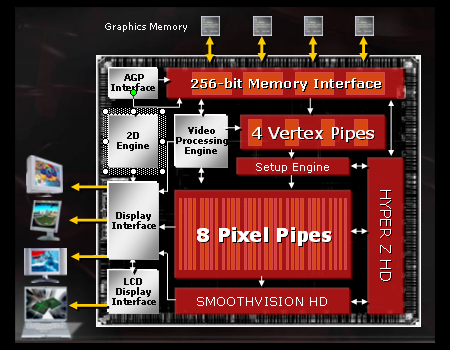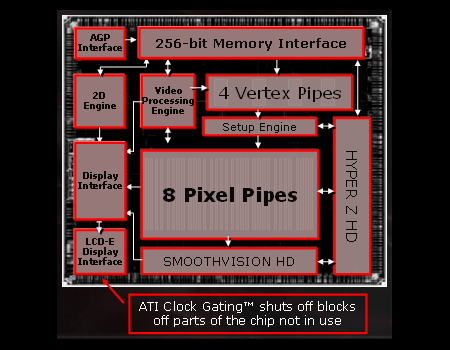ATI Mobility Radeon 9800: Notebooks Get Next Generation Graphics
by Derek Wilson on August 19, 2004 12:05 AM EST- Posted in
- GPUs
Good Things in Small Packages
As indicated earlier, the ATI Mobility Radeon 9800 is based on the R420 core, which powers ATI's latest X800 line of GPUs. In the past, naming may have been a bit of a stretch in terms of comparing mobile graphics solutions with their desktop counterparts, but this time around, the MR9800 bests the desktop 9800 cards in feature set (and doesn't fall that incredibly far behind in performance as we'll soon see).The MR9800 actually supports all the features of the Radeon X800, as it is simply a cut down version of the chip with some enhanced power management features. The real difference between current X800 GPUs on the market and MR9800 is in pixel/vertex pipelines featured. The new mobile chip has 8 pixel pipes and 4 vertex pipes. This also makes the MR9800 look more like a desktop 9800 in fillrate and processing power per clock cycle (though the R420 core will be more efficient). ATI also points to their new chip as the first mobile part to support 256MB of memory using a 256bit wide memory interface. This feature is also a result of the larger power budget available to ATI when targeting the DTR space.
To get a good idea of what's under the hood of MR9800 (and just how alike the desktop X800 really is), here's a block diagram of the chip from ATI's presentation on the part:

Even though ATI had a larger power budget to work with than usual, they couldn't ignore the fact that people will want to be able to use the battery in their system at some point, and thermal and power management both still play a large role in the DTR space. In order to satisfy these needs, ATI's mobile team worked alongside their desktop team to bring power and thermal management features to MR9800 through the R420 design cycle. This allows the R420 to fully support ATI's Powerplay technology right out of the fab. This is why we're seeing the release of a mobile R420 part so soon after the desktop release.
Powerplay is made up of a couple different features. To highlight, we'll touch on a few here. With Power-on-demand, ATI can dynamically adjust clock speeds and voltages based on the usage of the GPU at any given time. This will help to extend battery life when not pushing the graphics subsystem, as will user controlled GPU power management settings. Another important power/thermal management feature of Powerplay is Clock Gating. This amounts to the ability of the GPU to turn off parts of itself when not in use. The granularity of this capability is illustrated in the following slide from ATI's presentation:

We know that in the past, in order to play video, ATI couldn't completely turn off the 3D pipeline, but we are not sure if they have altered this limitation in the MR9800. We'll look into the matter in the future, but this question should answer itself (in video playback tests) when we start seeing reviews of notebooks featuring this GPU.
That does it for the technical details; it's time for some numbers.










31 Comments
View All Comments
nserra - Monday, August 23, 2004 - link
Thanks for the reply and it's really impressive that a 256bit memory interface is going into the mobile market so soon.I also don’t understand the problem about the driver? Is it about the time taken to release a new one (validation)? What i do is to force the last catalyst to install, it have worked just fine with me.
ATIMobileGuy - Friday, August 20, 2004 - link
#28 nserraKeep in mind the development cycle for mobile designs is longer than desktop development - when the design was started there were still questions on GDDR3 power and availability at the time, so we felt DDR was the ideal solution for the initial mobile introduction of this type of product. Plus, running at 300MHz and using the full 256-bit memory interface we felt the memory bandwidth was pretty good for a mobile design.
This is not to say GDDR3 is not going to show up in Mobile soon - as I said in post #26, there are a lot of surprises coming your way in the future. ;-)
nserra - Friday, August 20, 2004 - link
To DerekWilson and/or ATIMobileGuy:On you nvidia Geforce5800 review about ati Anisotropic Filtering: http://www.anandtech.com/video/showdoc.aspx?i=1779...
“Since there is virtually no difference between ATI's Performance and Quality modes, …..”
Does this still hold true in today’s games?
Since I could get some nice performance boost according to these charts
http://www.anandtech.com/video/showdoc.aspx?i=1779...
nserra - Friday, August 20, 2004 - link
To ATIMobileGuy:-If this is for the mobile market, why not use the new GDDR3 memory, since it would lower the power consuming and heat and deliver higher speed.
-Isn’t these chip a "little" waste of time if taken into desktop, since you guys already have a very similar chip but at .15, or we will only will see it on notebooks for the time.
DerekWilson - Thursday, August 19, 2004 - link
#22 suryadWe actually had the XPS in early July IIRC. We used ATI's latest drivers at that point. I'm not sure what driver the current Dell release is based on, but maybe Darren (ATIMobileGuy) can help us out there ;-)
ATIMobileGuy - Thursday, August 19, 2004 - link
Comment 5 [I](Posted by Anemone)[/I]Anemone, thanks for the comments. Without saying too much, I can tell you that this was really our first attempt at a new class of product, and once we move into PCI Express we'll have a few more surprises for you that should make you happy!
ATIMobileGuy - Thursday, August 19, 2004 - link
Re: Comment 20 (the esteemed Mr. Baumann)This is true Dave - unlike the desktop side, every Mobile driver is customized for each notebook for things like power management, hot keys, panel support - all kinds of things. If ATI were to provide "generic" drivers the user would run the risk of losing a lot of features or would experience potential instability.
The OEM has to do a lot of qualification to test all these unique aspects of their driver before feeling comfortable releasing it. Dell has been very good in understanding the need for fresh drivers, expecially for this segment, so I think it won't be too long before you see a new driver release for this system from them.
ATIMobileGuy - Thursday, August 19, 2004 - link
Hi Everyone - I'm Darren from ATI Mobile group. Just finished reading the review, and wanted to read the comments and see if there was anything I could answer from the comments that were posted; will be checking in sporadically and will give some responses to some of the things that have already been posted if possible.jediknight - Thursday, August 19, 2004 - link
Doom 3 benchmarks, please!!suryad - Thursday, August 19, 2004 - link
I have a similar specced Dell XPS and I was initially getting a 5440 with 3dmark but then I used Dells release of the 4.8 Catalyst drivers and that alone pushed me to a 6600 on 3dmark and over 43.1k in Aquamark3 all stock settings. Now I am not saying that the benchmark is the tell all in this situation but where these benches performed using the latest driverset? I am curious since I have yet to install any new games on it and wanted to know if I would get a performance boost sorta similar to what I got in 3dmark.